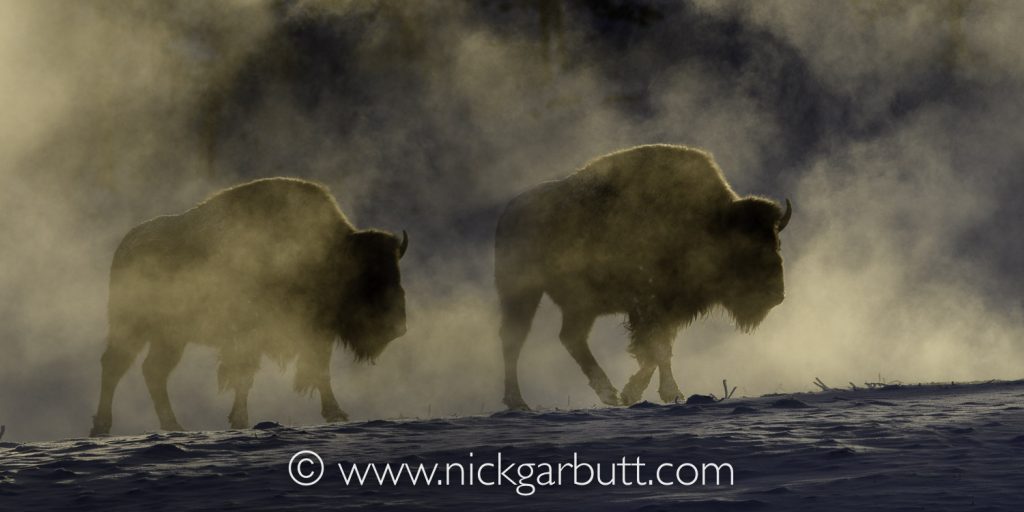Yellowstone 2018 Trip Report: Northern Exposure

A cottonwood encrusted with hoar frost in the Lamar Valley
In a previous life, I think I might have been a cowboy. I love the American West: the grandeur of the landscape, the culture, the turbulent recent history, the spectacular wildlife, and of course the movies. Whenever, I visit Montana and Wyoming, I genuinely feel like I’m walking in the footsteps of the old cowboys and native Americans of yesteryear. It’s hard to imagine what it was actually like. The acute hardship of frontier life less than 200 years ago is so far removed from today’s cushy existence, yet a visit to Yellowstone, especially in winter, alludes to what the entire extent of the northern Rocky Mountains must have once been like. Close your eyes and you can imagine scenes with native American tribes and early settlers passing through.
My winter tour to Yellowstone has become a regular fixture on my trip schedule and its allure remains as strong as ever. Perhaps more than any other destination I visit it offers something different, because in Yellowstone the landscapes are every bit as fascinating and arresting as the wildlife within. So photographically I am not simply interested in getting nice pictures of the various species encountered. What I really want are images that set species in the context of the environment, their home, where they eke out an existence.

In a morning white out, a stand of dead lodgepole pines with resting bison

Three bull bison plough through deep drifts in a snow storm in the Lamar Valley

Three trumpeter swans on the upper Yellowstone River in the Hayden Valley
The tour in January / February 2018 followed the same itinerary as in previous years (if it ain’t broke, don’t fix it): four days in the Northern Ranges concentrating on areas in and round the Lamar Valley, four days in the Old Faithful area with time along both the Madison and Firehole River valleys and four days at Canyon, where the Hayden Valley and the Grand Canyon of the Yellowstone are the two main areas of focus.

On occasions when the temperature plummeted there were some spectacular hoar frosts: here a grove of cottonwoods photographed when it was -24°C.

A pair of coyotes search for food along the banks of the Madison River

As the morning sun creeps over the horizon, a pair of bison wander through plumes of steam in the Firehole River valley

A herd of bighorn sheep dig into deep snow in search of grazing in the Lamar Valley
Winter temperatures in Yellowstone often drop to below -20°C, creating magical landscapes laden with intense frosts. Sadly, this time around, the temperature rarely dropped to be seriously cold, which slightly compromised some of the photographic opportunities we had hoped for. Nonetheless, over the duration of the trip we enjoyed some magical encounters and photographic sessions. The four days we spent in the Northern Ranges this time around was particularly rewarding with excellent encounters with bison, bighorn sheep and red foxes.

A bull bison tries to find some grazing beneath snow along the banks of the Firehole River
Along the Madison and Firehole Rivers, there were several sightings of coyotes hunting along the margins as well as some frosty bison and various species of waterfowl like Barrow’s and common goldeneye. On previous trips, this area has also been a good place to look for bobcats, that can sometimes be encountered as they stalk waterfowl along the banks of the rivers. Unfortunately, this time around we failed to find one.
In the Hayden Valley, bison and coyotes were repeatedly seen, as well as hunting otters and a very large herd of trumpeter swans on the upper Yellowstone River, but frustratingly red foxes that are often regularly encountered, were very scarce.

An amazing wolf sighting near Nymph Lake north of Norris Junction. This is the Wapiti pack - 15 individuals - that had killed a bison early in the morning

Three wolves tear at what remains of a bison carcass the pack had killed earlier in the morning

Two wolves feed heavily on the remains of a bison
Perhaps the highlight of the trip came in a meadow just to the north of Nymph Lake near Norris Junction. Here an entire pack of 15+ wolves was seen close to the road. Earlier in the morning they had brought down an adult bison and the pack had spent the morning gorging. By the time we arrived, much of the carcass had already been eaten and many of the wolves were lying down satiated, but at least four different individuals came to feed while we watched and given this was barely 60m off the road, the sighting offered some of the best wolf photo opportunities I’ve ever enjoyed.

Bison and coyotes on the banks of the Madison River

A lone tree stands in a sculptured snowscape in the Hayden Valley

In the Hayden Valley, a lone male bison pushes deep snow to one side to try to get to the grass beneath
In January / February 2019, I will be running two consecutive winter trips to Yellowstone and the tour will also be repeated in January 2020. To find out more please click here.
